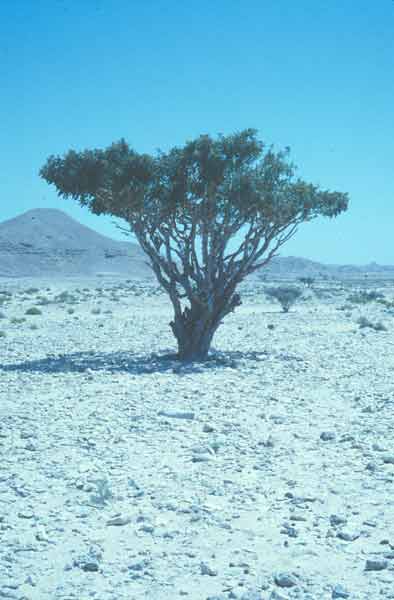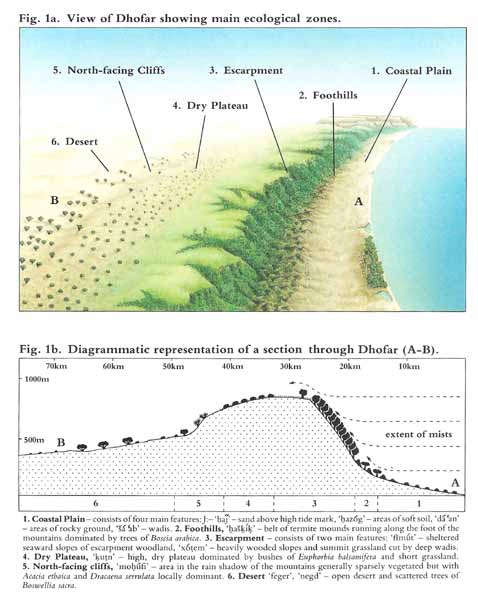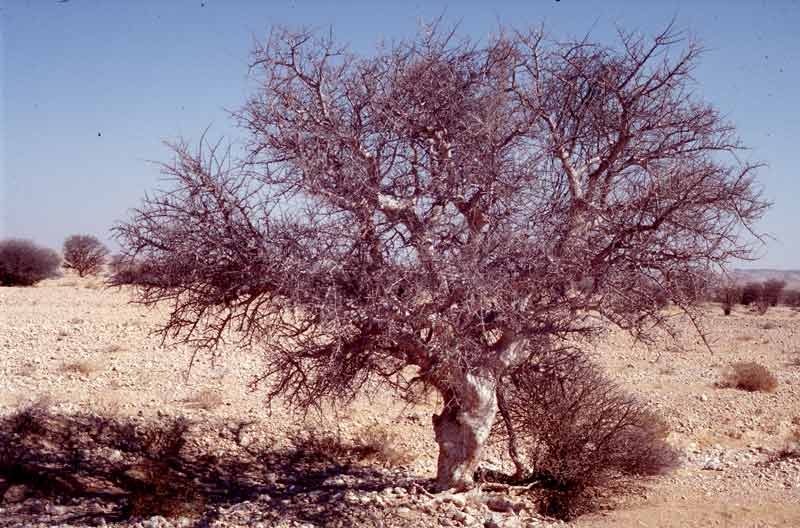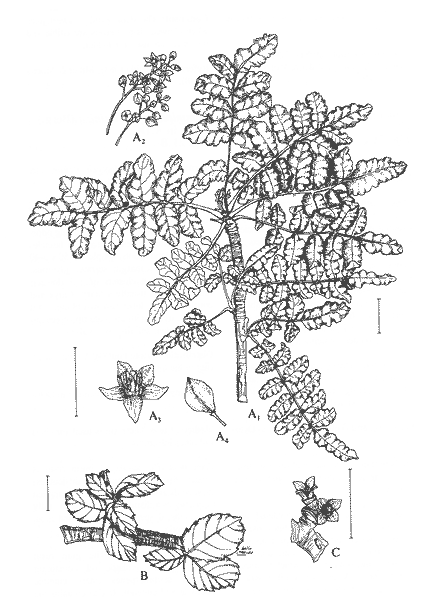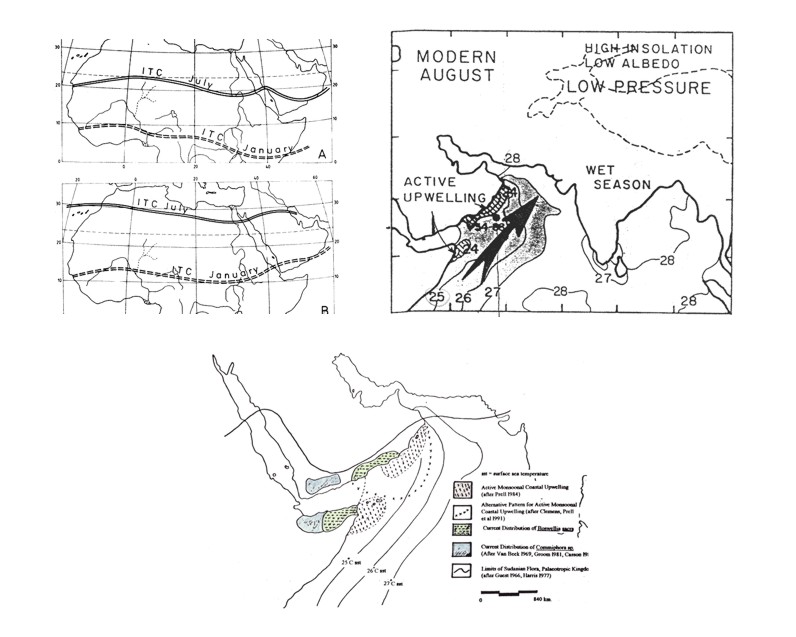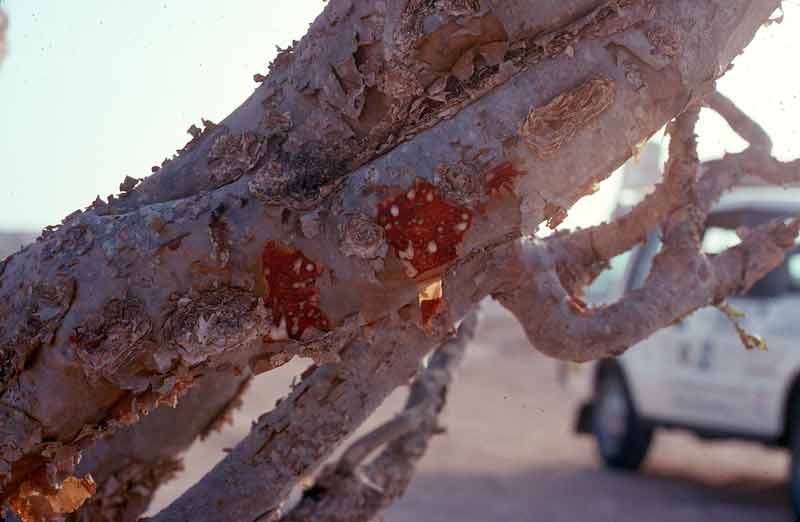The Archaeology Fund
Incense in the Land of Arabia Felix
|
Traditional incense (Arabic bahur/liban) comes
from two major plant genera - frankincense labelled Boswellia sacra and myrrh
from a number of different species belonging to the genus Commiphora .
Frankincense is the easier of the two incense types to recognize. It is identified only
Most authorities, see these succulents as
originating in the East African early Tertiary. This idea is based on the fact that over
24 different species of Boswellia are known from Africa and a startling 185 species of
The present-day distribution of the incense trees,
as defined by botanists, is well known to end on the eastern end near Jebel Samhan
but on the west, it tends to become diffuse with frankincense trees ending near
Habban. Myrrh species continue well into the Arabian uplands to the northwest. Their
North-South distribution also tends to be flexible. Frankincense trees in the Salalah
Plain can be found practically on the high crags along the seashore, but they disappear in
the woody and grassy upland scarp and plains. The best and most potent incense (Dhahabay)
comes from trees located in a dry belt 35 km. wide well beyond the moisture-rich Dhofar
cliffs and grassy uplands. However, today, the drastic dryness of the Arabian interior
causes the incense plants to soon disappear beyond this point. To the west in Yemen,
frankincense trees appear to inhabit a dry upland plain well north of the coastal scarp
and myrrh species begin to appear in abundance. Since the pattern of the incense trees is
correlated directly with the range and intensity of the Southwest Monsoon, we must
determine what changes the Southwest Monsoon had in the major periods of interest to us,
namely in the Iron (1000 BC-600 AD), Bronze (2500 BC-1000 BC) and Neolithic (6000-2500 BC)
periods. A number of factors have been studied to suggest that as early as the Neolithic
period, the Southwest Monsoon range was was much greater than at present. This extent has
often been measured in something called thee Inter Tropical Convergence Zone (ICTZ) and it
has been postulated to lie as far north as central Arabia. It may be that incense trees,
associated with this very strong monsoon, may have existed as far north as the Nafud
desert creating a very different natural range. Incense is collected by making incisions in the
tree trunks and the exuded sap crystallizes into nodules at the base of the tree.
These nodules are then harvested after two weeks and packed into sacks [The Economics of
Production]. Shipment was by overland caravans or by sea trade [The Economics of Trade]
The actual mechanics of day to day work, the economics involved, and harvest participants
themselves [The People Involved] create a complex picture stretching across much of
southern Arabia. Historical records describing the region suggest a similar complexity
heightened by a greater internal and external demand. Actual incense fragments have been
found in a variety of settings from at least 5000 years ago . At least eleven graves at
Nagada in Upper Egypt dating to the mid-fourth millennium B.C. contained graves goods
described as "resin lumps" (see Baumgartel 1970; Zarins 1996:93-94. From
the 18th Dynasty site of Akhataten (Tell-el Amarna) terebinth resin (Pistacia
terebinthus) is identical to that found at the Ulu Burun wreck in eastern Turkey
dated to the same time period and found in numerous amphora (Haldane 1993 for the list of
organic cargo). According to chemical nalysis, frankincense may have been carried in a
previous cargo prior to the ship skinking (Hairfield and Hairfield 1990). From Qana (Bir
Ali) and Khor Rohri lumps of 2000 year old frankincense have been found. Studies of the chemical composition of incense have linked it to a myriad of uses including medicinal applications [The Chemistry of Incense]. Since at least 1965, chemical studies have also foscussed on trace characteristics of incense from a variety of types and sources. Currently, our study of frankincense samples suggests they create a distinctive regional fingerprint. Consequently, both modern and ancient samples could be identified by region much like obsidian [link]. Fossilized sap, called copal, [Fossil Incense] has been mined from sources in East Africa and traded as beads/pendants, and varnish base over a wide area as well. |
|
 with one species and its range in southern Arabia is generally recognized to follow
the rain shadow of the current southwest Monsoon. This climatic phenomenon affecting only
Yemen (including Socotra) and Oman is closely tied to the location and spread
of these unique genera and species . Myrrh, in contrast, has a large number of species
many of which are to be found in southern Arabia. A significant number can be found to the
west of the frankincense range, stretching well north into the Arabian Asir mountains .
The full extent, of course, for these two genera occurs in the Horn of Africa, perhaps as
far west as the Sudan and as far south as Kenya.
with one species and its range in southern Arabia is generally recognized to follow
the rain shadow of the current southwest Monsoon. This climatic phenomenon affecting only
Yemen (including Socotra) and Oman is closely tied to the location and spread
of these unique genera and species . Myrrh, in contrast, has a large number of species
many of which are to be found in southern Arabia. A significant number can be found to the
west of the frankincense range, stretching well north into the Arabian Asir mountains .
The full extent, of course, for these two genera occurs in the Horn of Africa, perhaps as
far west as the Sudan and as far south as Kenya.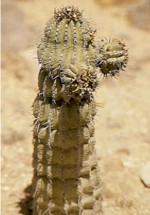 Commiphora. These succulents are part of a much larger group found in southern Arabia and
include a number of catalumas, aloes, and such exotica as baobab trees (imported during
historical times?) , dragonsblood trees, and other plants (Adenum obesum). The presence of
termite mounds also mirrors the ecology of the East African plains.
Commiphora. These succulents are part of a much larger group found in southern Arabia and
include a number of catalumas, aloes, and such exotica as baobab trees (imported during
historical times?) , dragonsblood trees, and other plants (Adenum obesum). The presence of
termite mounds also mirrors the ecology of the East African plains.